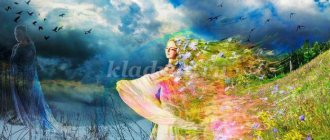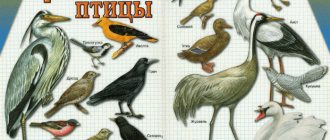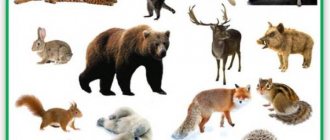Summary of an educational lesson in the senior group on the topic: Birds in spring
Lesson in the senior group on the topic: Spring
Author: Irina Filippovna Yumshanova, teacher at the Savinsky Kindergarten, Savino village, Perm Territory, Karagay district. Description of the material: I offer you a summary of a lesson for children of the older group (5-6 years old) on the topic “Birds in Spring.” This material will be useful to teachers of the senior group. This NNOD outline aims to promote children's cognitive development.
Goal: To promote the cognitive development of children Objectives: 1) Expand knowledge about the life activities of migratory birds; 2) Teach the ability to write a short story about birds; 3) Foster a caring, caring attitude towards birds; 4) Develop imagination; Progress of the lesson Educator: Guys, today I suggest you find yourself in the spring forest and listen to the sounds of the spring forest. What did you hear? Children: The birds sing, cheerfully... Educator: Of course, the birds sing their songs cheerfully and loudly. Birds appeared on the street that were not there in winter; where did so many birds come from? Children: from warm countries, from the south. Educator: This is the main miracle of spring - it is in spring that our feathered friends fly to us, bringing spring on their wings. What do children call the birds that fly back to us in the spring? Children: migratory. Educator: pay attention to the miracle - a tree, but no birds are visible on it. I suggest you sing a call to call the birds. The call is “Little birds, little birds, come to us, a clear spring, a red spring, bring us.” At this time, migratory birds appeared on the tree. Educator: What birds did you recognize? Children: nightingale, starling, swallow, rook Teacher: also cuckoo, oriole, lark. Guess the riddle about one of these birds: “Flew to us with warmth Having traveled a long way Sculpts a house under the window From grass and clay” Who is this riddle about? Children: Swallow Educator: Look, the swallow has black wings, head, back, white breast, small, sharp nose. The tail is like two pigtails. Guess the following riddle: “Anyone will recognize his trills, He sings other people’s songs, An amazing singer Our beloved by all...” Children: starling Educator: Look what the starling looks like: it is black, its beak is sharp, its breast is speckled with white. And here is the beautiful oriole, she has yellow plumage, her wings and the tip of her tail are black. Children, together with the teacher, examine and compare other birds. Educator: What do birds make us happy about? Children: songs, beauty Educator: Yes, birds delight us with their plumage, wonderful colors, their singing, what do you guys think the birds sing about in the spring? Children: they are probably happy that they have returned home. Educator: Of course, they are glad that they returned to their homeland, they sing about what wonderful countries they have seen, about how difficult their path home was, they are glad to meet you. I suggest you now play the game “Magic Transformations” (We turn into a migratory bird and make up a short story about this bird) Guys, what will happen if the birds do not return to us in the spring? Children: we will be sad without them, there will be no one to sing songs. Educator: There will be no one to protect parks, gardens, forests from harmful insects. Insects will eat all the vegetation and destroy the harvest of vegetables and fruits. There will be no one to distribute the seeds of berries, herbs, and flowers. We won't hear their songs. Therefore, we must protect the birds and help them. The teacher reads the poem “So that the blooming gardens do not die in vain from harmful insects Always at any time of the year Take care of the birds, friends.”
In the spring, birds have a lot of worries, they build nests and hatch chicks.
Do you know what birds build nests from? Children: from grass, branches, leaves. The teacher shows pictures of various nests and talks about them.
1. A swallow makes a nest under the ridge of the roof, crushes clay with its nose, bathes it in the river, carries it with its nose.
2. The song thrush’s nest is simply a sight to behold, the outside is decorated with green moss, the inside is smooth like a cup: made of wood dust with saliva. 3. The remez bird collects fluff from a willow tree, makes a nest for itself, it is downy, soft, like a mitten, it hoists it over the water, on a young reed. 4. The nightjar bird does not build nests, it makes a hole between hummocks and hatches eggs in the hole, in the hole-nest there are three beautiful marble eggs, first two chicks hatched, how many have not hatched yet? 5. The oriole’s nest looks like a basket; she makes it in trees high from the ground, in a branch of thin branches. 6. And the nightingale settles in the bird cherry thickets, making a nest right on the ground. A physical education lesson is being held : “The cranes have flown in. They went to dance. Extend their legs. Smoothly flap their wings.” Educator: Guys, look, another bird has flown to our miracle tree. “A white-sided magpie flew to us from afar, didn’t say where it was, brought you interesting facts.” The teacher reads out the facts:
1. Did you know that the starling is a master of imitating the voices of different birds.
2. There are birds that love to talk. 3. Storks knock with one half of their beak. 4. Snipes - rapidly descending, spread the feathers on their tail and wings, and the air, passing through them, hums. Educator: Guys, what other concern do birds have? Children: lay eggs, hatch chicks Educator: otherwise he takes care, incubates, warms, protects eggs Children: mother is a bird Educator: female, and who feeds mother? Children: dad is a male bird Educator: and now I suggest you put a bird out of the “magic square” game and tell what kind of bird it is and where it builds its nest, what interesting things you remember about the bird. The children lay out the birds, the teacher approaches each one and asks what kind of bird it is. Teacher: Well done guys, you turned out to be beautiful birds, I think you will be good friends for the birds.
We recommend watching:
Lego technology in the system of additional education in preschool educational institutions Drawing on the theme of Spring in 1st grade step by step Abstract of educational activities on speech development in the senior group Monitoring of older children on cognitive-speech and artistic-aesthetic development
Similar articles:
Abstract of the GCD in the senior group for the implementation of the educational field "Communication" on the topic "Journey through the fairy tale Spikelet"
Spring games for children in kindergarten. Senior preparatory group
Spring birthday party in kindergarten. Senior group
Round dance game on the theme “Spring” in the senior group
Integrated entertainment for the senior group in the spring
Summary of educational activities in kindergarten. Senior group. Spring. Migratory birds
Synopsis of Organized educational activities in kindergarten.
Senior group. Author: Osina Olga Anatolyevna, teacher. Municipal budgetary educational institution of the city of Abakan “Child Development Center - Kindergarten “Chaika”. Description of the material: I offer you a summary of organized educational activities for children of the older group (5 - 6 years old) on the topic “Spring.
Migratory birds". This is a summary of an educational lesson using mnemonic techniques. This material will be useful to educators, methodologists, and students of pedagogical faculties. Abstract of OOD in the senior group.
Theme: “Spring. Migratory birds". Integration of educational areas: “Cognition”, “Communication”, “Reading fiction”. Goal: to develop children’s knowledge about the characteristic signs of spring and migratory birds. Objectives: Educational: to develop the ability to compose a descriptive story about spring, using mnemonics techniques. Developmental: develop elements of logical thinking. Speech: activate vocabulary on the topic, consolidate the names of migratory birds, their chicks, signs of spring (drops, ice drift, thawed patches, primroses), use generalizing words (migratory, wintering). Educational: to cultivate a caring attitude towards nature. Equipment: mnemonic tables, riddles, cards with birds, recording of bird voices, bird masks. Methodological techniques: game situation, conversation - dialogue, examination of mnemonic tables and conversation on them, dynamic pause “Find a migratory bird”, physical education, summing up. Progress of organized educational activities: Organizational moment. Educator. All the children have gathered in a circle. I am your friend and you are my friend. Let’s hold hands tightly and smile at each other. - Guys, I will smile at you, and you will smile at each other, so that we will be in a good mood all day. Main part. Educator. Drops are ringing in the yard, Streams are running through the fields, There are puddles on the roads. The ants will soon come out after the winter cold. A bear makes his way through the dead wood, the birds began to sing songs, and the snowdrop blossomed. S. Marshak. Educator. Guys, please tell me what time of year the poem is talking about? (About spring) Educator. That's right, about spring. What time of year is it now? What spring months do you know? What month is it now? - Let's remember the signs of spring and talk about spring. Magic pictures from the envelope will help us with this. (Children use the pictures and symbols to make up a story about spring: they take the pictures out of the envelope, explain it and put it on the board).
Children. In spring the sun warms up. Thawed patches appear. The snow is melting and streams are flowing. It starts dripping. Ice drift begins on the river. Insects wake up. Flowers appear - primroses. Green grass appears. The buds are swelling on the trees. Birds arrive and begin to build nests. Educator. What birds do you know? (Answers)
Children, look out the window, who came to visit?
(drawings of birds are attached to the curtain: migrating on one side, wintering on the other).
- Look carefully at the birds.
Does anyone know why the birds are distributed among different flocks? (If they find it difficult to answer, then they need help). Educator. What do we call the birds that winter with us? (Wintering). Educator. Find wintering birds and name them. (Do it) Educator. What are the names of birds that fly to warmer climes for the winter? (Migratory). Educator. What do all birds have in common? (Puts out pictures - symbols, children take turns telling)
Children. All birds have a beak, 2 wings, 2 legs, their body is covered with feathers and down, they emerge from an egg. Educator. How are they different from each other?
Children. The color of the plumage, the size, the shape of the tail. Educator. Migratory birds are our guests. To find out which ones, let's solve the riddles. The blackest of all migratory birds, Cleans the arable land from worms, Jumps back and forth across the arable land, And the bird’s name is... (rook). Everyone knows this bird: Its palace is on a pole, It carries worms for its chicks, It chatters all day long... (starling) Under the roof I make a nest From lumps of clay. For the chicks I put a downy feather bed on the bottom. (swallow) Three children take masks of a rook, starling, and swallow. Educator. And now we will play the game “Find a migratory bird.” We stand around the birds. (Children are divided into three groups. Each forms a circle around one of the children wearing a mask.)
Remember your birds.
Now they will fly to the music and peck grains. When the music ends, you must find your bird and surround it. The group that forms a circle the fastest wins. Music is playing. With its end, the children search and find their bird. Educator. Well done! They played well. And now we will play the game “Fourth Wheel”. Didactic game “The fourth odd one” (based on pictures)
Swallow, sparrow, rook, starling.
Crow, stork, dove, sparrow. Rook, tit, swallow, cuckoo. Magpie, sparrow, woodpecker, swallow. Pigeon, cuckoo, heron, crane. Educator. Why are these birds called migratory? (Because in the fall they fly to warmer climes and return in the spring.) Educator. What is worse for migratory birds: cold or hunger? (Hunger, because they only eat insects, and you can hide from the cold.) Educator. In spring, birds have a lot of important things to do. What do birds do in spring? (They build nests, hatch chicks, feed chicks.) Educator. Now we will play the game “Name the chicks.” What are the chicks called in a duck - ducklings, in a goose - goslings, in a stork - chicks, in a rook - rooks, in a starling - starlings, in a nightingale - nightingales, in a crane - cranes, cuckoos - cuckoos. A picture of a birdhouse is put on the board. Educator. What is the name of this house? Who built it? What bird was the birdhouse built for? Physical education minute. We walk through the forest, observing nature (walking in place with head turns to the right, left)
We looked up at the sun, and the rays warmed us
(raise our heads up)
Birds sit in nests
(crouch)
Birds fly across the sky
(wave their arms)
And They jump around the bumps
(they jump in place)
And no one cries
(they smile) Educator. Guys, what are birds for? (Destroy insects - pests. Make us happy with your singing.) Educator. Let's remember how to handle birds and talk about what not to do and why. (Children make sentences based on pictures - symbols).
Children. You can't kill insects because birds eat insects. Nests should not be destroyed because birds hatch their chicks in them. You can't shoot birds with a slingshot because you might hurt them. Summarizing. Educator. Guys, please tell me what we talked about in class today? What new have you learned? What did you like most? What caused the difficulty? We got up. They turned to face each other and smiled. They offered their right hand, shook their left hand and said, “Well done.”
We recommend watching:
Abstract of OOD in the senior group on the topic “What is autumn?” Summary of OOD for the middle group. Planting onions Synopsis of organized educational activities in the senior group ZPR Synopsis of organized educational activities for children of the senior group
Similar articles:
Summary of organized educational activities for children of the senior group






